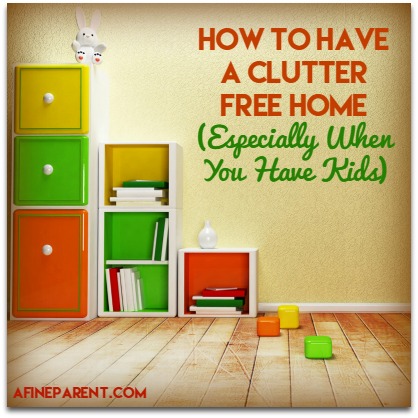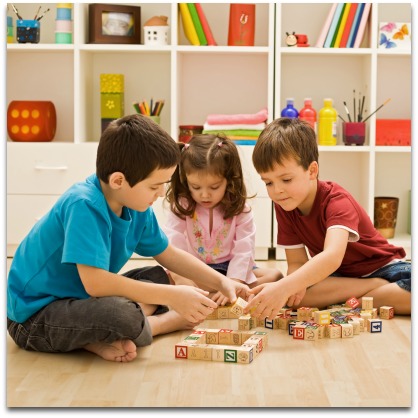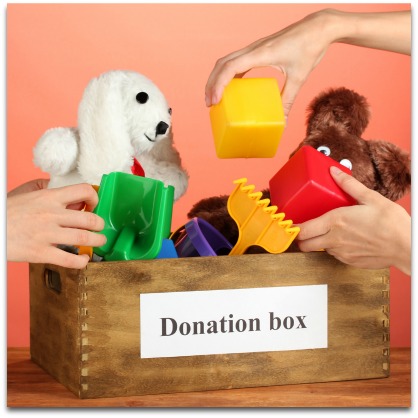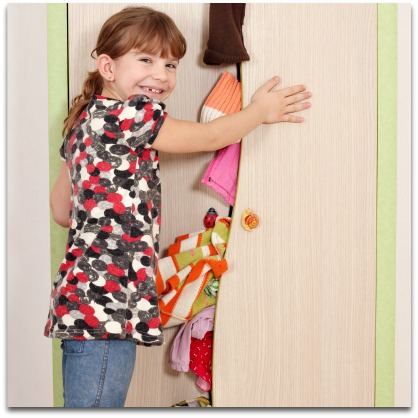 It’s amazing how clutter just happens, especially when you have kids, isn’t it?
It’s amazing how clutter just happens, especially when you have kids, isn’t it?
It doesn’t matter whether you work a job or you’re at home; if your kids are toddlers or teenagers –the to-dos and whatnots just keep piling up in corners, on surfaces and in that one special drawer.
Toys overflow their baskets and our feet painfully discover Lego bricks in the dark.
Mount Laundry grows like a volcanic peak — in the laundry basket, the corner of the bedroom and yes, even on the couch.
No matter how much we pick up, there’s always an endless supply of clutter. My husband and I, tired from our days, would ignore the piles. Then my keys would go missing. Or he wouldn’t be able to find his work badge. And we’d clean in a frenzy, snipping at each other about how we’ve failed yet again at the seemingly simple task of maintaining a clutter free home.
It looks like we were not the only ones struggling with this issue though.
According to a study conducted by UCLA’s Center on Everyday Lives and Families (CELF), clutter can lead to depression, anxiety and tension in the home.
Clutter starts small, but soon becomes overwhelming. We postpone decluttering until it niggles at our peace of mind a little bit each day, and eventually becomes a stressed-out frenzy that eats up an entire weekend leaving a trail of bitterness and exhaustion in its wake.
Last year my husband and I decided to break this cycle and take on the challenge of completely decluttering our home and keeping it clutter free.
At first it felt like a lost cause – no sooner had we freed up one corner of our home from clutter, new clutter piled up elsewhere in the home. It felt like a game of whack-a-mole.
Slowly though, we noticed something that changed the nature of the game and gave us the winning advantage. Most of the clutter in our home came from 5 specific sources. Simply by focusing on nipping each of these little sources in the bud, we have actually tamed the clutter monster.
Our home doesn’t necessarily look like it is from the pages of the Home and Garden magazine, but it sure is a far cry from where we were a year ago. Here are some of the secrets to having a clutter free home, especially when you have kids –
Tackle Clutter Source #1: Laundry — The Never Ending Saga
 The Dilemma: Unless your family decides to become nudists who never use towels or sheets, your laundry is never done. Embrace this fact, and work within its constraints.
The Dilemma: Unless your family decides to become nudists who never use towels or sheets, your laundry is never done. Embrace this fact, and work within its constraints.
The Solution: The first order of business is to have a laundry collection system that actually works.
We use tall bins next to our machines, one for whites and one for colors. We all have baskets in our rooms. Two or three times per week, we and the kids all bring our laundry down and sort it into the baskets near the machines.
Next, set a schedule so that laundry does not become overwhelming. We used to have piles of clothes so deep and wide that we couldn’t reach the machines. The more clothes that piled up, the more urge we had to just shut the door and walk away.
My family now commits to one load of laundry per day. We throw it in the wash before we leave for work, and we pop it in the dryer on our way in the door at night. We try to take it out after dinner, fold it and put it away. It doesn’t always work out that way, but we’re a work in progress. We do find that we’re much happier when we stick to the laundry schedule.
Because the laundry is at a minimum, our outfits and specific articles of clothing are easier to find. For example, my daughter always has a clean set of gym clothes ready. Before we instated our laundry system, she would search frantically through the heaping pile of to-be-folded clothes, or worse, she would have to take a dirty shirt to school.
If your children are over the age of six, they can be enlisted in the task of laundry. You do not have to suffer alone. Let your young kids put their own clothes away. By age ten, teach your children how to run the machines, and have them take turns doing the daily load. Make it clear that everyone puts away their own clothes.
Whether you commit to one load per day, or three loads per week, the key is to schedule your laundry so that it doesn’t pile up. Make your routine fit your family’s needs. Stick to your laundry schedule, and you’ll find it a lot easier to maintain a clutter free home since you’ll never have to scale the imposing Mount Laundry again.
Tame Clutter Source #2: Toys, Toys Everywhere!
 The Dilemma: Did you know that toys weigh twice as much when you’re putting them away as when you’re taking them out to play? They gain even more weight if your home has stairs.
The Dilemma: Did you know that toys weigh twice as much when you’re putting them away as when you’re taking them out to play? They gain even more weight if your home has stairs.
Okay, not really, but according to my kids, this must be true.
If your children are like mine, all things are dropped randomly once interest is lost. And there those things stay until the house is an unnavigable ocean of plushies, Lego bricks, art supplies, games and the occasional important piece of homework hiding beneath.
The Solution: Toy control is a three-pronged approach: Limit, Contain and Donate.
Limit: Reduce the number of toys your child has available at any given time. This doesn’t necessarily mean they have to be removed from your home. Get storage bins that can be placed on high shelves or under the bed, and remove half of your child’s toys. Every three months, rotate the toys out, placing those that were not used in the bins, and retrieving stored items one-for-one.
When we rotate toys out, the kids feel like it’s their birthday. They find toys they forgot they owned, and their interest is renewed. Sometimes they even surprise us and suggest that we donate certain items that no longer interest them.
Limiting toys simplifies the cleaning process for the kids. We have a bookshelf in the game room that contains games and Legos. Both of these activities require the use of the game table. My kids know that they have to put all of the Legos back into their bins before taking out a game.
Similarly, we keep all game boxes. When a game is finished, all the pieces go back into the box, and the box goes back onto its shelf. Because we keep the shelf’s contents limited , there is never a question as to where something belongs.
Contain: Employ the What-Not Basket trick. Place small baskets or bins near your living room or stairs, and drop items into each child’s basket when you see it left around the house. Have your kids clean out their baskets as they get full, or once per week as necessary. Encourage your children to make use of their baskets.
Examine the storage systems you employ for toys. I realized that large bins overflowing with random toys are as stressful and unmanageable for the kids as are our piles of paperwork and random stacks of household items. Find small bins, appropriate for the size of a single type of toy collection, and label them. My daughter has bins specifically for Littlest Pet Shop animals, and another for accessories. My son has a small bin of matchbox cars, and all of his Pokémon cards are contained in binders. Give toys a specific home, and work with your children, teaching them to put their things away in these pre-determined locations.
 Donate: Once or twice per year, enlist your child in the donation process. Many parents feel it’s easier to clear out the unused toys without their children’s input. However, making your child a part of this process teaches her the difference between want and need. Your child comes to understand that it’s okay to let go of items that no longer hold meaning for us. Plus with a donation receipt and a few free tax tools, you can take advantage of a tax deduction when you file your return for the year.
Donate: Once or twice per year, enlist your child in the donation process. Many parents feel it’s easier to clear out the unused toys without their children’s input. However, making your child a part of this process teaches her the difference between want and need. Your child comes to understand that it’s okay to let go of items that no longer hold meaning for us. Plus with a donation receipt and a few free tax tools, you can take advantage of a tax deduction when you file your return for the year.
My children were born hoarders making it very hard for us to maintain a clutter free home. Everything was special. They had to keep all the things! Involving them in the donation process over the last year has helped them realize that it is okay to let go. Just last week, my daughter surprised me by voluntarily donating her American Girl doll. Her reasoning was that she’d outgrown it, didn’t play with it, and another little girl would love to have it. She realizes those dolls are expensive, and it made her feel good knowing that it would bring joy to another child.
My hope is to raise adults who understand that material possessions don’t equate to happiness. Moreover, I want them to make material possession an active, conscious choice, thus reducing the stress that comes from clutter.
Eliminate Clutter Source #3: The Crap-Catching Surfaces and Drawers
The Dilemma: We come home tired, knowing that there is still dinner, homework, baths and bedtimes ahead of us. We drop our junk mail, to-dos and other odds-and-ends onto specific surfaces, or we cram them into that one drawer until these areas of our homes are overflowing and unmanageable.
The Solution: Resist the urge to drop-and-forget. When you pull the mail from the box, you know right away which pieces can be tossed. Throw them away immediately. Set a garbage bin near your entry door specifically for paper waste, and trash those junk pieces the second you enter the house.
Purchase a wall organizer for important mail, keys, work badges, etc. and commit to using it every day. The one I use can be found here. Put this organizer near your junk mail can. File bills and important mail in their appointed places, and commit to a half-hour, once per week to clear out and handle those items.
Stop Ignoring Clutter Source #4 – Stuff That We Just Step Over
 The Dilemma: With the above 3 main sources of clutter taken care of, we noticed that there was a lot less stuff piling around the house. But like I said at the beginning, clutter just has a way of happening.
The Dilemma: With the above 3 main sources of clutter taken care of, we noticed that there was a lot less stuff piling around the house. But like I said at the beginning, clutter just has a way of happening.
Your children come home from a birthday party, tired and wired, and the goody bag gets dumped on the living room floor. Your daughter’s sleepover activity of “make your own bath salts” results in abandoned bags, bottles and jars all over the bathroom. Your son’s school project took way longer than expected, and the supplies get left all over the table in his haste to go to bed.
We parents tend to be perpetually tired, too. One look around a cluttered house, and the exhaustion doubles. We decide to take care of it later. But then later never comes. In our family, we would push off picking up until it became overwhelming, and we’d end up cleaning in a frenzy while verbally sniping at each other. It’s not a fun way to live.
The Solution: We have found that the best solution is to make a family commitment to a change of habit and rewarding ourselves for sticking to our decluttered life and ensuring we have a clutter free home.
Decide on a number of items that each person promises to pick up and put away each time they get up from the couch or screen. Encourage the kids to pick up after each other by making use of the what-not bins.
Designate specific storage bins or drawers for art and school supplies, and remind the kids to put away pens, crayons and excess paper after homework. Use time between activities to put away, rather than ignore.
Reward yourself with a bubble bath, a hot cup of tea or ten minutes of reading when you find that your home is not requiring constant cleaning.
Enlist every member of the family, and reward the kids when you see them picking up. We have marble jars for each of the kids. When they are caught being helpful, we put a marble in their jar. At the end of the month, we count them up, and the kids are rewarded. Mine are old enough that marbles have turned into allowance money. Younger kids can be rewarded with movies, trips to the park or family bike rides.
Resist the urge to use a “treasure box” as a reward system. Those just cause more clutter! I found that treasure box rewards, though small and mostly useless, became Big Important Things. My kids formed hard attachments to the treasure box items because they were positive rewards for a job well done. They became permanent fixtures at the bottom of the toy box.
Finally, Vanquish Clutter Source #5 – Stuff that Piles Up Over Time
 The Dilemma: Daily declutter habits start us down the path of simplification and reduction of excess and a relatively clutter free home. But the process takes time, and meanwhile clutter still happens.
The Dilemma: Daily declutter habits start us down the path of simplification and reduction of excess and a relatively clutter free home. But the process takes time, and meanwhile clutter still happens.
Our closets catch items that don’t have obvious homes. Our bookshelves become disorganized with daily use. The kids outgrow clothes, and their drawers overflow. Tax paperwork and bill receipts pile up even though they are no longer required. Kitchen gadgets break and get shoved back in drawers. We ignore all those clothes in our closet that we no longer wear.
The Solution: Schedule regular Family Declutter Days on your calendar. Pick one room and go through the clutter spots together. We help our children declutter their bedrooms. They help us sort through old books, games and movies in the den. We all work though the art supplies, removing the old, broken crayons and determining what needs to be replenished. My husband and I declutter our bedroom together.
Decide as a team what to keep, sell or donate. Finish the process completely in that one day. Do not box items and tuck them into closets or the garage; take donation items to your drop-off of choice. Put everything else in its appointed and appropriate place and be done.
You Can Achieve a Clutter Free Home and a Low-Clutter Life!
Having a clutter free home doesn’t mean that your home is 100% picture perfect all the time. Magazines belong on your coffee table. Games are played in your living room. Find your balance between utility and tidiness. You don’t have to live in a spot-free, model home. I find that there are certain types of clutter that bother me, and there are others I can live with. I simply choose to ignore the latter.
It has been less than a year since my family embarked on our declutter journey, and we’re already seeing results. It’s not perfect, but then when is perfection ever a part of the family equation?
Once we get a firm handle on one set of daily declutter tasks, we search out new ideas and work them into our lives. The result in our home is less stress, and fewer days of digging ourselves out from under the endless stream of stuff that somehow finds its way into our home.
The 2-Minute Action Plan for Fine Parents
When you look around your home, ask yourself –
- Are you or your family members holding onto items that you will never use again? If you can’t repurpose or reuse, can you sell, recycle or donate those items?
- Do you find that one surface gathers the most clutter? Can you commit to avoiding that surface for a week, and see what a difference it makes?
The Ongoing Action Plan for Fine Parents
Make decluttering a family lifestyle. No parent, working or otherwise, should do all the decluttering alone.
Stress the importance of want vs. need to your children (and to yourself). Some things are sacred, but everything is not.
Make a schedule of rooms for decluttering, and stick to the plan. Combining short bursts of daily work with longer, deeper cleaning monthly, your house will become clutter-free within the span of a year.
Hey, I’m definitely one of those who still stock up clothes. But sometimes, feel like I need to let it go. Probably selling it or giving it to charity. Thanks, sort of reminder.
Great post! I was just thinking about writing a post about how to keep your house clean when you have kids lol. I love the tip about the dustpan and scooping stuff up! I will have to include that one in my list for sure. I will link back to you. Thanks for sharing
I’ve got a solution. Stop buying so much stuff.
LOL. Yes, that works, when it works.
And then there are the “other” times.
In the past 3-4 days we haven’t bought anything and yet all of these have appeared out of nowhere –
– the laundry and dishes (Shanan, you forgot about dishes! And I didn’t catch it!!!), because even when we don’t buy anything, we still have showers, breakfast and dinner
– party favors – try prying that out of a 6 year old’s hands
– winter jackets – because it was awfully cold yesterday, but it isn’t today, and it will be tomorrow, so out they will stay for a day
– wet umbrellas – can’t put them away until they dry
– craft “stuff” – i enjoy watching my daughter totally absorbed in multi-day projects, but it also means there will be stuff out for a day or two
– grocery bags – we have a “no plastic bags” ordinance and if you don’t air out the reusable bags, I’m worried they’ll start smelling
– miscellaneous paper – seriously, where did that come from??!!
To get back to the point, I’m all for reducing what we buy. But don’t believe for one minute that is enough to tame the clutter (especially when we have kids at home!)
Dishes! How could I forget? Maybe it’s a mental block. LOL
Yeah, we buy very little more than necessities (outside of birthdays and Christmas).
Where the heck DOES that paper come from? Oh, right… the kids empty their backpacks and “might” need to keep those old assignments. The receipts from my purse… FLING! while looking for my sunglasses in a hurry. Oh great…. theses credit card offers have a bunch of personal information on them… I really need a shredder, for now I’ll just put them…. yeah… that list just keeps going.
There is a serving dish sitting on my bar that belongs to my neighbor. It’s been moved from the kitchen table to the pool table to the bar to the counter, and back to the bar. Eventually it WILL make it the distance back to her house.
One time, I went to vacuum and part of my living room floor was covered with acorns. Like… 100 acorns. I know I didn’t buy those…
Much of the clutter we encounter has very little to do with what we buy, but with what is just carted in, or what is used daily (laundry, dishes, school supplies, tools, papers, etc.).
Great tips Shanan. I think the key is consistency in implementing them – that’s what I find the hardest! 🙂
Consistency is key! And the other trick is to remember that there will be times when it’ll still sneak up on you, and that’s ok. I find the more we declutter, the easier it is to reclaim our own sanity when we get behind for a few days.
Totally agree, Susan. What’s been helping us with it is to have a designated spot for everything, so even if we slip up sometimes, catching up becomes easy. For instance, I can point to the pile of hair clips, doodle bands etc. on the the counter and raise an eyebrow at my daughter and she’ll know where they are all supposed to go. I’m with Shanan on this — some temporary clutter is acceptable, as long as there is some sort of balance between utility and tidiness (and it doesn’t clash with my borderline OCD 🙂 )
I LOVE your laundry idea: put it in in the morning and dry it at night. That alone will make a big difference. I have a pack-rat kid, so will try the containment ideas, too. Thanks for sharing!
Great! I hope it works for you! It works wonders for us, when we stick with it. Our hardest part is putting it away. The couch is not a dresser… right? LOL
We are a 3-loads-on-the-weekend family, Marie and so it’s really been working well for us. Having to fold 3 loads at once used to make me want to weep before, but now I have a standing date for a phone call with my mom (back in India) on Sunday nights. By time we catch up on all the gossip of the world, my laundry folding is done and I don’t even realize it 🙂
The biggest takeaway for me was the idea of the “what-not” basket. Hadn’t heard of it before, but LOVE it and it makes so much sense!
“Did you know that toys weigh twice as much when you’re putting them away as when you’re taking them out to play? They gain even more weight if your home has stairs.” <—– Made me Laugh out loud. Thanks for a great read.
You’re welcome! Glad you enjoyed it! Now I just need to remember to follow my own advice. We let it go for a week… one week…. and I spent yesterday digging out again! LOL
I LOL’d at it first too, but soon remembered how true it is in our house as well! So it’s a fairly universal thing, huh? Also, apparently toys taken out during a play date, but not put away before friends leave apparently weigh 5 times as much… Oh, well. They’re only little once 🙂
Interesting ideas. One thing we do in our house is the “before computer” rule. My kids are only allowed to play with their iPads AFTER showers are done, and toys are put away, and rooms are cleaned. We have nice sized cubby closets and the kids must put all the toys in the closets before computers. They don’t have to be organized in the closets, but they do have to be in there before they get computers. Then, before they go to bed if any toys have been missed anywhere in the house they get one more chance to put them away or they go in the trash. So, the main idea is toys put away before computers, and toys thrown away after bed. It’s amazing how the house is ALWAYS clean before I crawl into bed myself ^_^
Ah, to be able to sleep in a house that is ALWAYS clean (drool).
We used to have a kind of similar rule before when our daughter was younger — “toy cops” visited our house every night after we slept and took away any toys that weren’t put away. As our daughter has grown older though, I’ve stopped the “toy cops” story (don’t want her questioning my bluff). Also, she has started doing multi-day craft projects now… I enjoy the fact that she is focused/dedicated enough to work on one project for several days, but not so much that the stuff stays out until the project is declared done. Oh, well!
That’s that delicate balance between utility and a tidy house. Right now, my kids have a Littlest Pet Shop village set up in the game room. To me, it’s “stuff everywhere.” But it’s also a sign that they plan to play together nicely for several days in a row. I know they’ll lose interest in the game (and each other… then it’s brother/sister war, chapter 3519 😉 ) and then I’ll have them pick up.
LOL, Shanan. This comment makes me want to look for a plugin which lets me like/upvote comments. 🙂
😀
Shannon, I have noticed this phenomenon too 🙂 Now I try and make the clean up a game as well so that I don’t have to do it all by myself. Work in progress on that one.
Mary, I have noticed this phenomenon too 🙂 Now I try and make the clean up a game as well so that I don’t have to do it all by myself. Work in progress on that one.